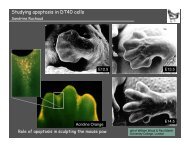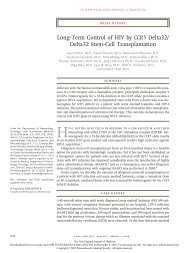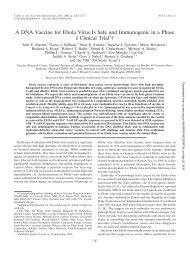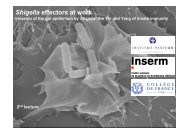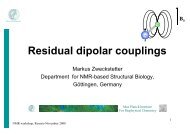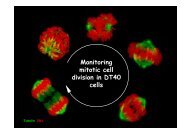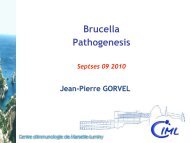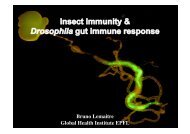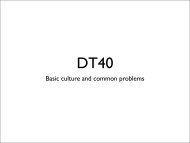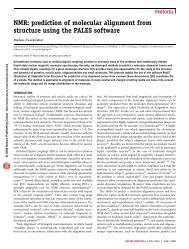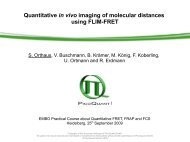pdf file - Events - EMBO
pdf file - Events - EMBO
pdf file - Events - EMBO
You also want an ePaper? Increase the reach of your titles
YUMPU automatically turns print PDFs into web optimized ePapers that Google loves.
<strong>EMBO</strong> Plant DNA Repair and Recombination Workshop, Presqu'île de Giens, France 2007<br />
one to target a DSB to essentially any position in the genome of any cell, and yield rapid,<br />
selection-free, high efficiency gene correction (8) and gene addition (9) at endogenous<br />
loci. We will describe recent progress in designed ZFN technology: our development of<br />
massively parallel tools for studying genome editing, the structure-based redesign of<br />
ZFNs aimed at ensuring single-locus specificity of the editing process, and the remarkable<br />
efficiency of single-step endogenous gene disruption we have observed in a broad range<br />
of cell types. 1. Rouet, P., et al. 1994. Proc Natl Acad Sci U S A 91:6064-8. 2. Kim, Y. G., et<br />
al. 1996. Proc Natl Acad Sci U S A 93:1156-60. 3. Bibikova, M., et al. 2001. Mol Cell Biol<br />
21:289-97. 4. Porteus, M. H., and D. Baltimore. 2003. Science 300:763. 5. Lloyd, A., et al.<br />
2005. Proc Natl Acad Sci U S A 102:2232-7. 6. Wright, D. A., et al. 2005. Plant J 44:693-<br />
705. 7. Pabo, C. O., et al. 2001. Annu Rev Biochem 70:313-340. 8. Urnov, F. D., et al. 2005.<br />
Nature 435:646-51. 9. Moehle, E. A., et al. 2007. Proc Natl Acad Sci U S A 104:3055-3060.<br />
----------------------------------------------------------------------------------------------------------------------------------<br />
P - 37. Strategies to modify and monitor gene targeting and meiotic<br />
recombination in crops.<br />
Philippe Vain, Vera Thole, Barbara Worland, Katie Mayes, Upendra Devisetty, Chanate<br />
Malumpong, Sean Mayes. Agricultural and Environmental Sci (Biosciences), University of<br />
Nottingham, LE12 5RD Loughborough, United Kingdom<br />
Significant progress has been made recently in perturbing genetic recombination<br />
processes in model plants, particularly Arabidopsis thaliana and tobacco. While these<br />
approaches have not yet coalesced into practical and efficient methods to achieve Gene<br />
Targeting (GT) and to modify meiotic recombination, a firm foundation is being laid. We<br />
have been looking at opportunities to test promising results in model di- and<br />
monocotyledonous species, with an ultimate aim to manipulate these processes in crop<br />
species, particularly wheat. We have developed a deficient GUS-based marker system,<br />
which could be repaired by GT. As this system does not require plant regeneration, we<br />
can rapidly examine very large numbers of events. A number of genes involved in<br />
recombination, particularly in rice have been cloned into expression vectors and we are<br />
beginning to characterise the effect of these genes in A. thaliana as a first step. The<br />
system we have developed should allow the same recombination genes to be tested in a<br />
number of species (A. thaliana, tobacco and rice), allowing rapid follow up of positive<br />
results from models to crops. We will use the same transgenic lines that have been tested<br />
for GT effects to assess effects in meiotic recombination, through crossing and<br />
microsatellite analysis. In addition to this, we are currently screening neutron deletion<br />
material of wheat to identify deletion of specific homeologues of RAD51 and DMC1<br />
(which may not cause full sterility in this hexaploid) and intend to compare these with<br />
characterisation of rice Tos17 insertional inactivation lines for the rice equivalents (where<br />
two versions of each gene exist). Results to date and our future plans will be presented.<br />
----------------------------------------------------------------------------------------------------------------------------------<br />
P - 38. Reverse Progeny Mapping<br />
Aat Vogelaart, Johan Schut, Rob Dirks, Cilia Lelivelt. Celbiology, Rijk Zwaan Breeding BV,<br />
4793 RS Fijnaart, Netherlands<br />
A method is provided for mapping traits in organisms, in particular in plants. The<br />
method comprises a) providing a population of SDR-0 organisms, that each arise from<br />
one member of a population of unreduced cells resulting from second division<br />
restitution, in particular a population of unreduced spores; b) producing SDR-I progeny<br />
populations of each of these SDR-0 organisms; c) phenotyping the SDR-I progeny<br />
populations to identify segregating traits within each SDR-I progeny population; d) if<br />
segregating progeny is present in a SDR-I progeny population genotyping the<br />
corresponding SDR-0 organism and comparing the genotype thereof with the genotype of<br />
the other SDR-0 organism to identify heterozygous chromosomal regions associated with<br />
Page 47 sur 56



